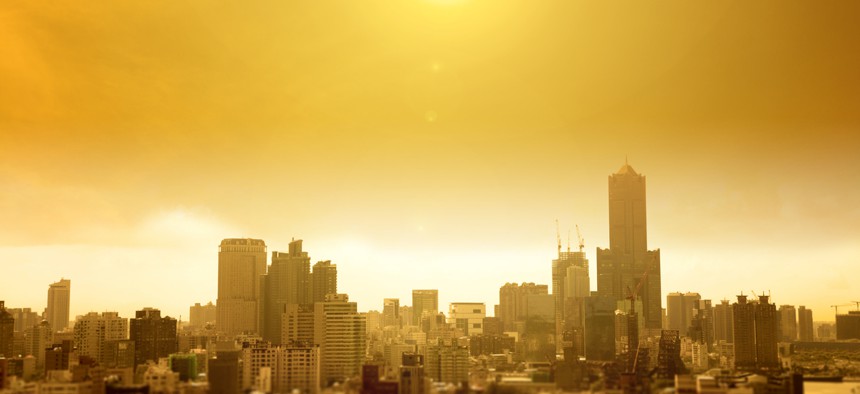As Temperatures Heat Up, Cities Need to Keep People Safe

The report's release comes as cities across the country brace for an extended streak of above-average temperatures. Shutterstock

Connecting state and local government leaders
A new guidebook, released by a disaster relief agency, offers strategies for cities to prepare for and learn from stretches of hot weather.
Heat waves will become more frequent as the planet continues to warm, but cities can mitigate the danger by preparing ahead of time in simple, often inexpensive ways, according to a planning guidebook released Tuesday.
“Simple, low-cost actions such as ordinary citizens checking on vulnerable neighbors can save lives during episodes of extreme heat,” wrote Francesco Rocca, president of the International Federation of Red Cross and Red Crescent Societies, the disaster relief agency that compiled the report. “As many as 5 billion people live in areas of the world where heat waves can be forecast before they happen, which means we have time to take early action to save lives.”
The “Heatwave Guide for Cities,” released Tuesday, comes as much of the eastern United States braced for a searing stretch of above-average temperatures combined with oppressive humidity. More than 20 states were under excessive heat warnings and heat advisories as of Wednesday afternoon. Eighty-five percent of the lower 48 states are expected to see temperatures that exceed 90 degrees in the next week, according to the National Weather Service, which classified the event as a “major heat wave.”
All types of communities are affected by heat waves, but the 96-page guidebook focuses on urban preparation due to the particular susceptibility of cities. That’s largely due to the “urban heat island” effect, where concrete and buildings "trap" heat and release it slowly. Preparing for those weather events is complicated, the report notes, because multiple agencies and departments are involved, and it’s often unclear which should take the lead in the planning process.
“A mandate to reduce heat risks does not fit squarely within any traditional sector or government department, rather there are a variety of agencies that have crucial roles to play in the overall effort to reduce heat risks,” it says. “The fact that heat risk does not fall neatly under one agency is part of the challenge in scaling-up heat action globally.”
Regardless of the specific strategy a city chooses, the steps are largely the same. The first is knowing when a heat wave is coming (paying attention to forecasts, the report says, is key), followed by disseminating information to citizens and making sure the risk is effectively communicated. (People who live in hot areas, for example, may not be inclined to heed warnings in the face of an impending heat wave.) The farther in advance a city can prepare—a metric that depends largely on adherence to forecasts—the better, per the report.
“For example, with a one-week lead time, a city may consider registering older people living alone and providing special visits to ensure they have adequate drinking water, access to cooling and information,” it says. “A one-day lead time may provide just enough notice to warn the public via TV, radio and social media about the impending heat wave and the actions they can take to reduce the risk.”
To best prepare, cities should begin planning well ahead of the hot season by identifying heat hotspots and vulnerable populations (typically the elderly, infants and children, people who work outdoors and people with pre-existing health conditions), assessing the health-care infrastructure and conducting long-term public awareness campaigns. Concrete action items can include providing cooling stations (particularly important for lower-income or homeless residents who do not have access to reliable air-conditioning), distributing water and preparing health-care workers for an influx of patients.
During the heat wave, the guidebook recommends that cities strive to keep citizens informed, organize home visits for vulnerable people and keep electricity and water systems running even if customers don’t pay their bills. Municipalities should also plan for increases in electricity demand as residents crank their air-conditioning units to cope with the heat.
“This stresses the generation, transmission and distribution of electricity, leading to blackouts or a reduced electricity supply,” the report says. “Serious disruptions to the electricity supply, as a result of higher peak demand, can have a knock-on effect for other infrastructure (e.g. hospitals) and essential services that depend on the steady supply of energy such as water provision in high-rise buildings.”
Cities across the country employed many of those tactics to prepare for this week’s hot spell. In York, Pennsylvania, officials moved trash collection times up an hour to protect outdoor workers. New York City opened cooling centers in all five boroughs and urged residents to stay inside as much as possible as temperatures began to climb. In Kansas City, officials urged residents to check on their neighbors, while city pools in Allentown, Pa. slashed their entry fees in half for city residents.
The work should continue when the heat wave has passed, the guidebook advises. City officials should let the public know the threat is over, and then assess how well their plans fared.
“An after-action review also helps those who responded to the heat wave understand how well existing plans worked and where there may be room for improvement,” it says.
Kate Elizabeth Queram is a Staff Correspondent for Route Fifty and is based in Washington, D.C.

NEXT STORY: How One City Dramatically Cut Its Murder Rate




